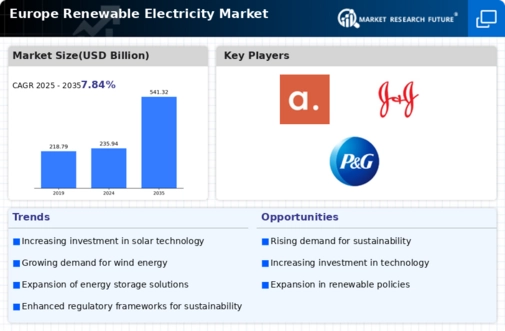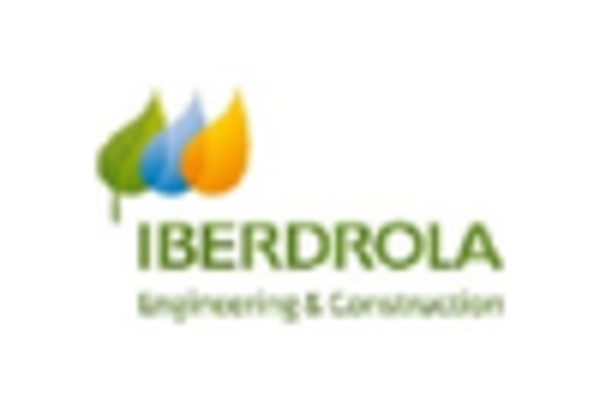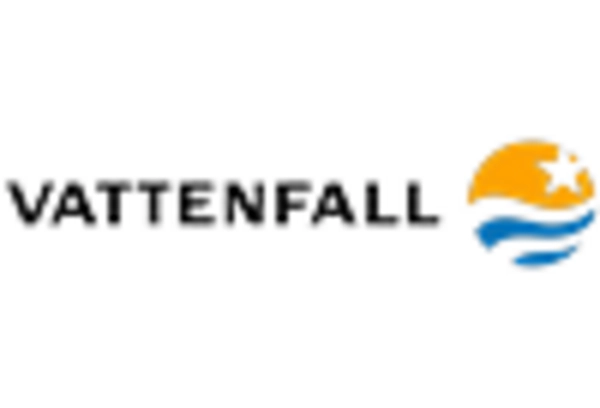Market Analysis
Europe Renewable Electricity Market (Global, 2023)
Introduction
Europe’s market for green electricity is undergoing a profound transformation, driven by the increasing emphasis on sustainable development and the need to respond to the climate change challenge. The shift towards green electricity from wind, sun and water is gaining momentum. This is transforming the energy landscape, but also driving innovation and investment in green energy. The green electricity market is characterised by a diversity of actors, both large and small, ranging from established energy companies to start-ups and governments. In parallel, the regulatory framework and incentives are being developed to support the integration of green electricity into the existing grid and to secure a more sustainable and resilient energy system for Europe. In the long term, the market for green electricity is expected to play a key role in shaping the region’s economic and environmental landscape.
PESTLE Analysis
- Political
- The European Union has a target of reducing greenhouse gas emissions by at least 55 per cent by 2030 compared with the level in 1990. This is a part of the European Green Deal. The Green Deal is a framework for action and has a budget of one thousand billion euros for climate-related investments in the next ten years. In addition, a number of member states have enacted their own national plans for the promotion of renewable energy. Germany, for example, has decided to ban coal mining by 2038, thus strengthening the political commitment to the use of electricity from renewable sources.
- Economic
- In Europe the electricity from renewable sources has attracted considerable investment, with an estimated 40 billion francs invested in renewable energy projects in 2023 alone. This investment is being driven by the need for energy self-sufficiency and the need to switch to sustainable sources of energy. In addition, the European renewable energy industry employs some 1,500,000 people, which shows the importance of this industry in the local economies and in the provision of jobs.
- Social
- In Europe, support for renewable energy sources remains strong. Recent opinion polls have shown that more than 75 per cent of Europeans want to increase the use of renewable energy sources. The support of the public is essential to the success of projects, as local communities are more likely to support initiatives that are in line with their environmental values. Hence the Commission has set up educational programmes and awareness-raising campaigns, which will reach over 10 million people by 2023, to raise awareness of the benefits of using renewable energy sources.
- Technological
- The advances in the field of solar energy accelerated in 2023. The cost of photovoltaics was down about 20 per cent on 2022 figures. Lithium batteries, which had been the principal source of energy storage, showed a further increase in capacity of about 30 per cent. These developments were essential to a reliable integration of renewable sources into the existing grid.
- Legal
- In 2023 the European Union imposed stricter rules on emissions and the production of renewable energy. The directive on the use of renewable energy in the European Union (RED) stipulated that by 2030 at least 40 per cent of the energy consumed in the European Union should come from renewable sources. In addition, the states were obliged to draw up national energy and climate plans, and those who did not comply were subject to penalties. The aim of this legal framework was to ensure that the countries met their obligations and that the overall goals of the European climate strategy were achieved.
- Environmental
- A study has been made of the climatic effect of the production of electricity from the sun and the wind. The result is very favourable. It is estimated that, by the year 2023, the total quantity of CO2 emitted in Europe by the various sources of energy will have been reduced by about 300 million tons. This reduction is essential in the fight against the greenhouse effect, and proves the necessity of a change to the more wholesome energy.
Porter's Five Forces
- Threat of New Entrants
- The European market for green electricity has seen a significant increase in the number of new players, thanks to the governments’ favourable policies and incentives. However, the high investment required for technology and for the necessary equipment, along with the administrative and regulatory obstacles, can pose a barrier to new entrants. The market share of the established players, and their financial resources, are also a challenge for the newcomers.
- Bargaining Power of Suppliers
- “In the field of new energy, the suppliers of materials and technology are relatively numerous, which weakens their negotiating power. The market is characterized by a large number of suppliers of components such as solar panels, wind generators, and other new energy systems. This gives companies the opportunity to easily change suppliers, which weakens the influence of any particular supplier.
- Bargaining Power of Buyers
- Buyers in the European renewable energy market have considerable bargaining power, thanks to the growing availability of alternative energy sources and the growing competition between suppliers. As consumers become increasingly aware of the environment and seek sustainable energy solutions, they are free to change suppliers at any time, which forces companies to offer competitive prices and better service to retain customers.
- Threat of Substitutes
- Despite the growing use of alternative energy sources such as solar and wind power, fossil fuels and atomic energy still play a role. However, the growing pressure to reduce carbon emissions and the falling cost of renewable energy sources will gradually reduce the attraction of these alternatives, although they will continue to pose a threat.
- Competitive Rivalry
- Competition is fierce in the European market for green electricity. Many players compete for market share. In order to gain a competitive advantage, companies are constantly developing and improving their technology. Also, aggressive price and marketing strategies are in place to ensure a competitive edge in a rapidly evolving market.
SWOT Analysis
Strengths
- Strong regulatory support from EU policies promoting renewable energy.
- Diverse energy sources including wind, solar, and hydroelectric power.
- Growing public awareness and demand for sustainable energy solutions.
Weaknesses
- High initial investment costs for renewable energy infrastructure.
- Intermittency issues with renewable sources leading to reliability concerns.
- Limited grid capacity and infrastructure to support widespread renewable integration.
Opportunities
- Technological advancements improving efficiency and reducing costs of renewable energy.
- Increased investment from both public and private sectors in green technologies.
- Potential for cross-border energy trading within the EU to optimize resource use.
Threats
- Geopolitical tensions affecting energy supply chains and market stability.
- Competition from traditional energy sources and potential regulatory pushback.
- Climate change impacts that could affect the availability of renewable resources.
Summary
In 2023 the European market for renewable electricity is characterized by strong regulatory support and a broad range of energy sources, which are being further pushed by the increasing demand for sustainable energy. However, challenges such as high initial costs and reliability problems due to the intermittent nature of the sources remain major weaknesses. Opportunities for growth are technological development and increasing investment, while threats from geopolitical tensions and competition from conventional energy sources could hinder development. Strategic focus on grid development and innovation is crucial to strengthen the strengths and opportunities and to counteract the weaknesses and threats.









Leave a Comment